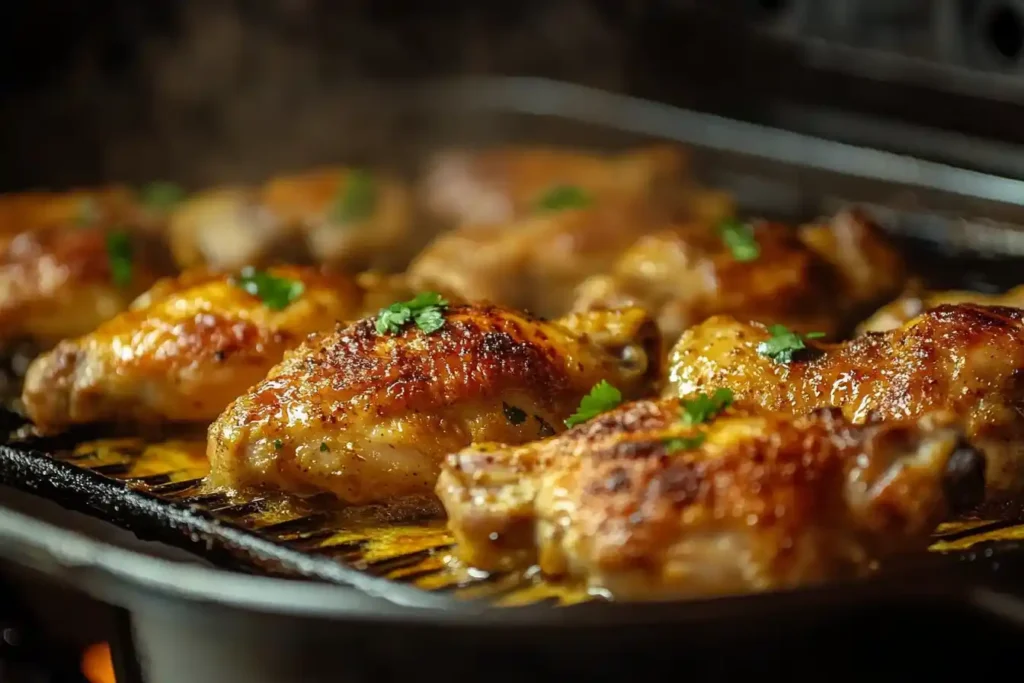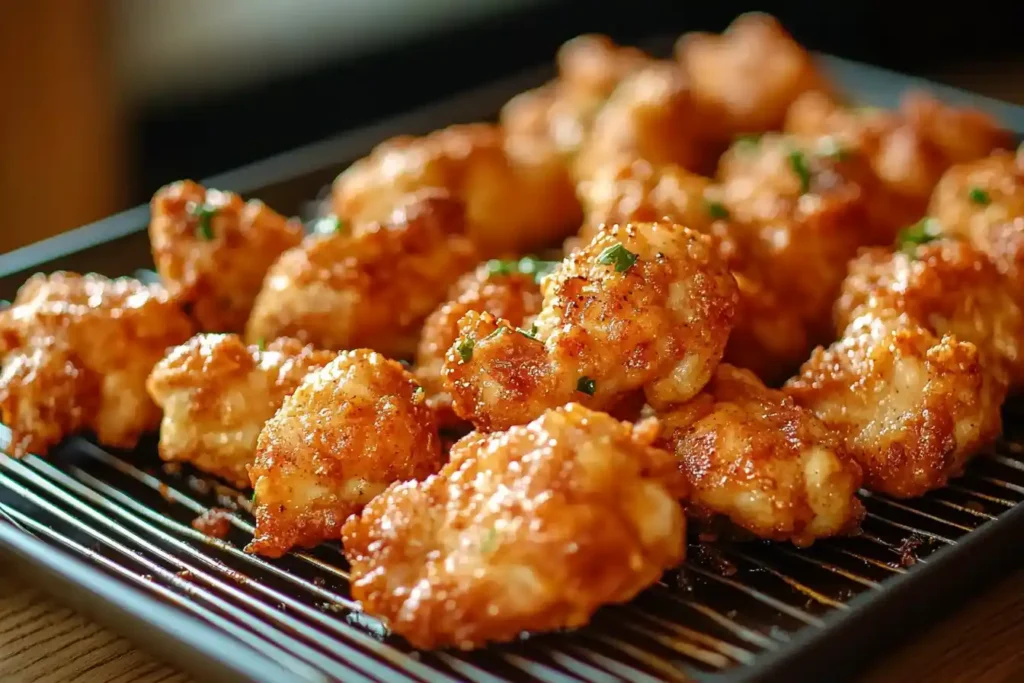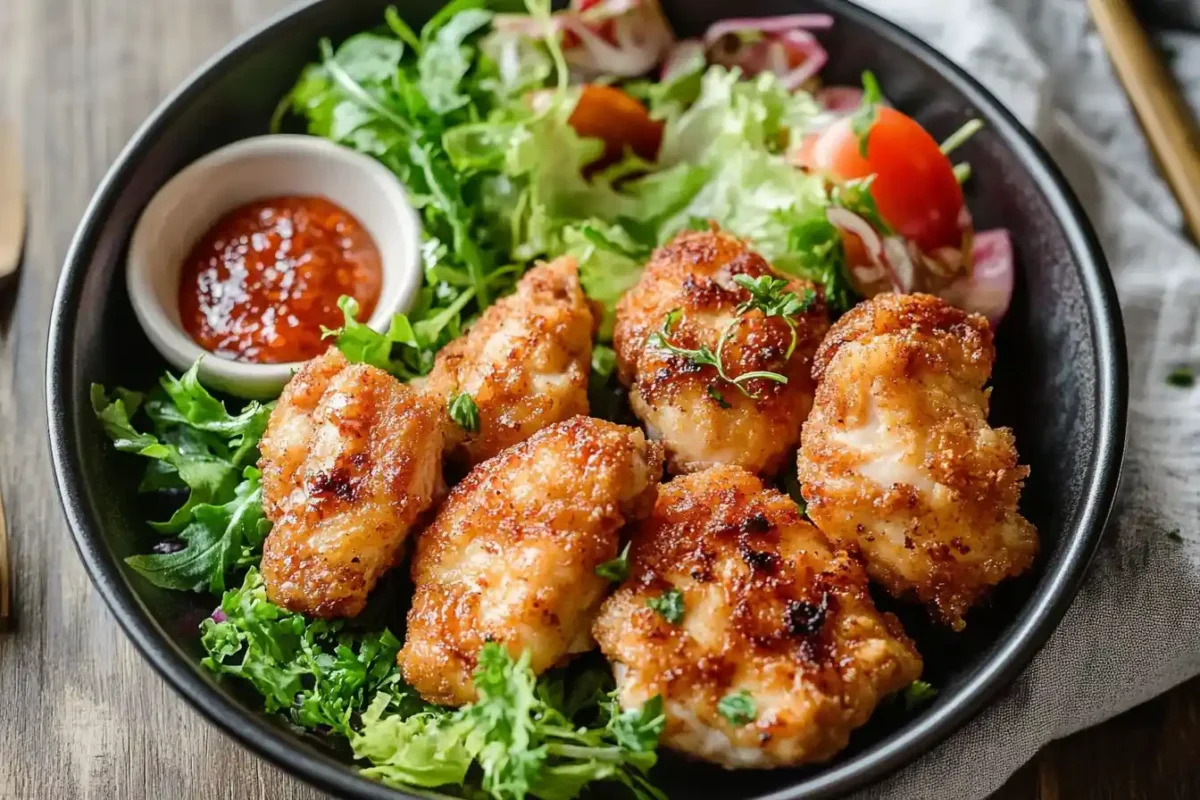Achieving crispy marinated chicken can be a kitchen challenge, but it’s entirely doable with the right techniques. For a comprehensive breakdown, check out A Complete Guide to Frying Marinated Chicken. This article will guide you through the process of transforming marinated chicken into a delightfully crispy meal.
Marinating Basics for Maximum Crispness
The Importance of the Right Marinade
Marinating chicken is a great way to add flavor and tenderness. However, some marinades can hinder crispiness. Therefore, it is important to choose your marinade wisely. Avoid thick, sugary marinades because these can burn before the chicken gets crispy. Instead, opt for a marinade with a good balance of acid, oil, and herbs. Accordingly, this helps tenderize the chicken without adding too much sugar. Furthermore, marinades with acidic components like lemon juice, vinegar or yogurt help to tenderize the meat.
Preparing the Chicken
Before marinating, make sure your chicken is dry. Moisture is the enemy of crispiness. Therefore, pat the chicken dry with paper towels before adding any marinade. This simple step will help the marinade adhere better and also helps promote a crispier skin during cooking. Moreover, consider making small cuts in the chicken’s skin to help the marinade penetrate deeper. This step also aids in achieving an even crisp surface.
The Key to Crispy Skin: Drying is Essential
Importance of a Dry Surface
Moisture on the surface of the chicken prevents it from getting crispy. The water turns to steam, which hinders browning. Therefore, it’s essential to eliminate as much surface moisture as possible. A dry surface is a primary requirement to achieve truly crispy marinated chicken. Indeed, the Maillard reaction, responsible for browning and flavor development, is less efficient in the presence of moisture.
Drying Methods
After marinating, remove the chicken from the marinade. Then, place it on a wire rack over a baking sheet. Afterward, let it air dry in the refrigerator for at least an hour. This air-drying method helps remove surface moisture. Moreover, patting the chicken with paper towels right before cooking ensures no additional moisture. Specifically, consider placing the chicken uncovered in the refrigerator for a few hours, or even overnight, for even better results.
Using a Binders for Added Crispiness
Specifically, you can add a light coating of cornstarch or baking powder to the chicken’s surface. This helps absorb any remaining moisture and promote crispiness. Indeed, this creates a barrier that helps the skin to brown more effectively. However, use these sparingly to avoid a powdery texture. Additionally, the binder creates a porous surface which helps in the formation of a good crispy crust.
Cooking Methods to Achieve Maximum Crispiness
High Heat is Crucial
High heat is key to achieving crispy skin. This creates a crisp exterior while keeping the chicken moist inside This creates a crisp exterior while keeping the chicken moist inside. Therefore, preheat your oven or pan thoroughly before adding the chicken. Basically, the high heat ensures a rapid development of the crispy layer before the chicken’s internal temperature rises too quickly.
Oven Roasting for Even Crispness
Oven roasting is a good way to achieve crispy results. Roast your chicken at a high temperature, around 400-425°F (200-220°C). Furthermore, placing the chicken on a wire rack in the oven allows air to circulate. Subsequently, the heat reaches all sides for even cooking and crispiness. Moreover, you can use a convection setting on your oven, as it helps circulate hot air more effectively, leading to even crispier results.
Pan-Frying for Enhanced Crispiness
Pan-frying can create an extra crispy crust on your marinated chicken. However, use a heavy-bottomed pan and preheat it thoroughly before adding oil. Place the chicken skin-side down in the hot oil. Then, press it gently to ensure even contact with the pan. Additionally, do not overcrowd the pan. This prevents the oil’s temperature from dropping and ensures that the chicken gets a crispy crust. Furthermore, cook in batches if needed. Comparatively, the direct contact with the hot pan aids in faster browning and crust formation, enhancing crispiness.
The Role of Oil and Fat
Using enough oil or fat is important for getting crispy skin. The oil helps to conduct heat evenly around the chicken. Basically, use a high-heat oil. Some good options are canola, vegetable, or avocado oil. Adding a touch of butter or chicken fat can also enhance flavor and crispiness. However, be careful to not add too much, or you might get a greasy result. Also, using a fat with a higher smoke point prevents the oil from burning before the chicken reaches the desired crisp texture.
How to Get Extra Crispy Marinated Chicken?
Increasing the Heat
Unquestionably, a key factor in how to get marinated chicken crispy is high heat. You can consider increasing the heat to 450 degrees Fahrenheit (232 degrees Celsius) during the last few minutes. This gives the chicken a final burst of high temperature, which leads to extra crispiness. Nevertheless, monitor the chicken closely to avoid burning. Specifically, you need to use an oven thermometer to ensure your oven reaches and maintains the required temperature.
Using a Combination of Cooking Methods About Crispy Marinated Chicken
Try a combination of pan-frying and oven roasting to get the best results. Initially, sear the chicken skin-side down in a pan for a few minutes. Then, transfer it to the oven to finish cooking. This combines the advantages of each method. Comparatively, this approach helps create a crispy skin and ensures the inside is cooked through. Additionally, the searing step allows you to develop a crispy exterior quickly, which you can then maintain as the chicken cooks through in the oven.
Tips for Avoiding Soggy Skin
Explicitly, avoid covering the chicken while cooking. The steam trapped by the covering will soften the skin. Additionally, ensure that the cooking surface or baking sheet is not overloaded. Overcrowding can lead to uneven cooking and soggy areas. Conversely, always keep ample space between the chicken pieces for best results. Moreover, using a wire rack for baking allows air to circulate and prevents the bottom of the chicken from getting soggy.
The Final Touches for Crispness
Let the chicken rest on a wire rack for a few minutes after cooking. This allows the skin to stay crispy while also letting the internal temperature even out. Finally, avoid placing the chicken on absorbent surfaces. Paper towels can make the underside of the chicken become soggy. Furthermore, the resting period lets the juices redistribute within the chicken, resulting in a more flavorful and tender outcome.

Understanding the Science of Crispness
The Maillard Reaction
The Maillard reaction is a chemical reaction between amino acids and reducing sugars that gives browned food its distinctive flavor. This reaction requires high heat and a dry surface. Therefore, drying the chicken and using high heat are important to achieve a crispy texture and a rich, browned crust. Hence, this reaction is fundamental to understanding how to get crispy marinated chicken.
The Role of Moisture
As mentioned earlier, moisture is a major obstacle to crispiness. Water boils at 212°F (100°C). Thus, as long as there is moisture present on the surface of the chicken, the temperature will not rise sufficiently for the Maillard reaction to occur efficiently. Specifically, the surface will simply steam rather than becoming crisp. Therefore, controlling moisture is vital for achieving perfectly crispy results.
Fat as a Heat Conductor
Fat is a great heat conductor and plays an important part in the crisping process. It distributes heat evenly around the chicken. Furthermore, a thin layer of fat or oil helps to create the right environment for crispiness to develop. Therefore, using an appropriate amount of oil is a simple yet vital step.
Advanced Techniques for Extra Crispness About Crispy Marinated Chicken
Double Frying
While more time-consuming, double frying can give you extra crispy chicken. First, fry the chicken at a lower temperature to cook it through. Then, fry it again at a higher temperature to achieve crispiness. Subsequently, the second fry removes any remaining moisture, which results in an extremely crispy exterior.
Using Baking Soda
Additionally, some chefs swear by using a small amount of baking soda. When mixed with other seasonings, baking soda helps to raise the pH level on the surface of the chicken. This process promotes a more intense browning, which ultimately leads to a crispier skin. However, use it in very small amounts to avoid any off-flavors.
The Importance of Proper Oil Temperature
Maintaining the correct oil temperature while pan-frying is critical. If the oil is too cool, the chicken will absorb too much oil and become greasy instead of crispy. If the oil is too hot, the chicken will burn on the outside before it cooks through. Therefore, use a thermometer to monitor your oil temperature and adjust the heat accordingly. Generally, the ideal temperature range for frying is between 325°F and 375°F (160°C and 190°C).
Troubleshooting Common Problems About Crispy Marinated Chicken
Why Your Chicken Isn’t Crispy
One of the main reasons chicken doesn’t get crispy is too much moisture. If the chicken is not properly dried, the skin will steam rather than crisping. Therefore, always ensure your chicken is dry before cooking. Also, overcrowding the pan or oven can hinder crispness. Furthermore, not using high enough heat is a common cause of soft skin.
Dealing with Soggy Skin
If your chicken’s skin is soggy, it’s likely due to one of the previously mentioned reasons. Specifically, increase the heat, ensure the chicken is dry, and do not overcrowd the cooking surface. Generally, you can rescue soggy chicken by placing it back in the hot oven. Or, you can quickly sear it in a hot pan skin-side down. Comparatively, a quick re-searing will allow the crispy skin to reform.
Adjusting Your Marinade
Some marinades prevent crispiness. Hence, you may have to adjust the marinade. If it contains a lot of sugar, switch to one with less sugar or simply add oil to it. Chiefly, experiment with different marinades until you find one that works well for achieving crispy marinated chicken. Indeed, the marinade should not prevent you from getting crispy results.

Conclusion: Mastering Crispy Marinated Chicken
Achieving crispy marinated chicken requires a combination of proper preparation, the right techniques, and understanding the science of cooking. Specifically, always start with dry chicken, use high heat, and avoid overcrowding the pan or oven. With careful attention to these factors, you can consistently create a crispy and flavorful meal. Ultimately, mastering how to get marinated chicken crispy enhances your cooking skills. Therefore, it is worth practicing this technique. Thus, with patience and practice, you will soon be enjoying perfectly crispy chicken every time. Furthermore, the joy of creating perfectly crispy marinated chicken will encourage you to try various variations and enjoy cooking more.
FAQs About Crispy Marinated Chicken
How to get crispy chicken after marinating?
To get crispy chicken after marinating, ensure the chicken is thoroughly dried before cooking. Also, use a high-heat cooking method like pan-frying or oven-roasting at 400°F – 425°F (200°C – 220°C). Air-drying the chicken in the refrigerator for an hour after marinating and then adding a light coating of cornstarch can also help.
How to get a crust on marinated chicken?
To get a crust on marinated chicken, pat the chicken dry after marinating to remove excess moisture. Then, sear it in a hot pan with oil, skin-side down, to develop a crispy crust. Avoid overcrowding the pan and maintain a high heat to achieve the best results.
What is the trick to getting crispy chicken?
The trick to getting crispy chicken involves several steps. First, ensure the chicken is completely dry by patting it with paper towels. Second, cook it at high temperatures, and avoid overcrowding your pan or oven. Lastly, use a small amount of cornstarch or baking powder to absorb additional moisture and promote crispiness.
How do you make chicken skin super crispy?
To make chicken skin super crispy, focus on removing all moisture from the skin before cooking. Let the chicken air dry in the refrigerator for at least an hour, or even longer. Cook the chicken skin-side down in a hot pan with oil, and add a small amount of baking powder or cornstarch to further enhance crispiness.

